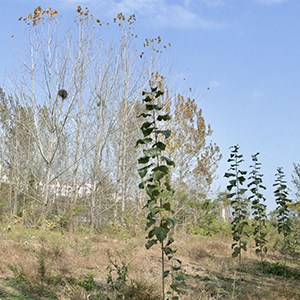In a forest, even trees have their generational conflicts. Young trees often find themselves under the canopy of the older trees. Their survival strategy is to kick off their growth earlier in spring and stay longer green in autumn. A research team from Umeå Plant Science Centre, SLU, and Huazhong Agricultural University in China has revealed that a small RNA molecule acts as a master regulator in aspen, modulating the length of the growing season in an age dependent manner.
The study was published this week in the journal Proceedings of the National Academy of Sciences (PNAS).
It takes time for a young tree in a forest to grow tall enough to escape the shading of the surrounding adult generation. To establish themselves, young trees employ a risky strategy: they extend their growing season to capture light before and after being fully shaded by the older trees. This phenomenon was observed earlier but it was not clear how trees adjust the length of their growing season based on age.
“Initially, we did not aim to study growth cessation but rather the role of a short RNA molecule – microRNA156 – known to control plant maturation,” explains Ove Nilsson, professor at SLU and group leader at Umeå Plant Science Centre. “These microRNAs bind to RNAs of other genes to degrade them or inhibit their activity.”
When the research groups of Ove Nilsson and Jihua Ding, a former postdoc in Ove Nilsson’s group, investigated how hybrid aspen trees responded to an increased activity of microRNA156, they observed that the trees stopped their growth and set their buds later than control trees. The researchers grew the plants under greenhouse conditions and simulated seasonal changes by adjusting temperature and day length. Under these conditions, the modified trees also opened their buds earlier.
“We did not expect this behaviour and got intrigued to study it further,” adds Jihua Ding who is now leading a research group at Huazhong Agricultural University in Wuhan, China. “We studied the literature and realized that several papers describe findings that juvenile forest trees often extend their growing season compared to older trees in the same forest. However, the underlying mechanisms were not yet understood.”
The researchers focused on the seasonal growth stop in autumn and analysed the molecular changes accompanying the increased activity of microRNA156. The activity of several genes known to control the timing of bud set in the fall was strongly affected in the modified trees. It turned out that microRNA156 acts as a master regulator during growth cessation through the so-called SPL genes and the central seasonal growth regulator FT2, connecting tree maturation and the regulation of seasonal growth regulation.
“The regulation mechanism that we discovered in aspen is different than what was previously described in the model plant Arabidopsis,” says Ove Nilsson. “Perennial trees have evolved different survival strategies than annual plants, and it is obvious that these strategies are regulated differently dependent on the age of the tree. When we better understand the underlying mechanisms of these strategies, we can gain a clearer understanding of how trees adapt to a changing environment and climate change.”
The article
Xiaoli Liao, Yunjie Su, Maria Klintenäs, Yue Li, Shashank Sane, Zhihao Wu, Qihui Chen, Bo Zhang, Ove Nilsson and Jihua Ding. Age-dependent seasonal growth cessation in Populus. PNAS (2023). https://doi.org/10.1073/pnas.2311226120
